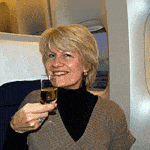India Travel Tips: Delhi to Mumbai
We flew to India on British Air World Traveler Plus from Los Angeles to Delhi via London. Seats are a little roomier with 2 seats configured at the window – same food as economy, but close access to lavatories and a bit of privacy. Fare was about $2500 per person and worth it for the distance in flight.
We arrived in Delhi in the morning and were assisted by A&K meet and assist services. They helped us through immigration and escorted us to a private, comfortable, air conditioned car for transfer to the Taj Mahal Hotel in New Delhi.
The hotel is set amidst lush gardens and is centrally located, but not within walking distance of city life. It is located amid upscale residences and near some of the famous monuments of the area.
Delhi is spread out over 1,485 Square km and home to people from all over India. We soon learned discovering India meant hearing one impressive statistic after another pertaining to numbers of people and animals, sizes of structures, years in existence, number of rulers and rivers, height of mountains and its close proximity to enemies.
Upon meeting our tour director, Vishal Ghai, we knew immediately we were in for a very special introduction to India. It was apparent he had a passion for introducing visitors to his country and gently helping them understand and embrace their India travel experience.
Over the next 12 days we would learn:
• India has a population of 1.2 billion people.
• There are four major religions and eighteen official languages
• The Hindu religion has 330 million gods/goddesses
• India has 60,000 miles of railroad carrying 30 million people a day
• 1.1 million soldiers (India is second largest contributor to peace keeping efforts)
• Thirty three percent (33%) of Parliament seats are reserved for women
• The World Health Organization just removed India from the list of Endemic Polio countries
• Bollywood produces 3 new movies a day.
These are just some of the amazing statistics which helped us understand what we were seeing on our India tour.
The daily stories, cultural insights and legends imparted to us by Vishal intrigued us and drew us deeper into the mystery and fascination that is India, plus making the long rides between some cities pass very quickly. His management of our relief stops was beyond significant.
Most of our hotels were Taj Palace Hotels, real palaces dating back hundreds of years and possessing some of the most beautiful, historical artifacts in India. In Agra we stayed at the Oberoi Amarvilas with views of the Taj Mahal. In Jaipur it was the magnificent Taj Rambaugh Palace. The Taj Lake Palace on Lake Pichola was our fantasy home for two nights in Udaipur. In Jodhpur we were guests at the Umaid Bahwan Palace where I experienced a first – an exquisite rose scented bath sprinkled with real rose petals and drawn by the butler before we entered the room after check in.
Beautiful, fragrant flowers abound in these exclusive hotels, inside and out, and throughout our experience in India. At the Taj hotels arriving guests are showered with rose petals and then receive the traditional bindi or tilaka– a red dot gently placed on your forehead symbolizing the third eye or the mind’s eye.
The traditional verbal greeting is namaste (nah-ma-stay) with a slight bow of the head, hands folded as if in prayer. These traditional acts were warmly embraced by our group. This simple greeting and humble acknowledgment toward others sets an aura or tone of courtesy and respect. Perhaps it explains why all in our group felt sincerely saddened when the time came to leave India and our intrepid traveling companions of the previous 12 days.
Some of the sites we visited on this tour included the Jama Masjid and Ghandi’s Memorial in Delhi; Taj Mahal, Akbar’s Mausoleum and the Agra Fort (all UNESCO World Heritage Sites) in Agra; Fatepur Sikri (similar to China’s Forbidden City and another UNESCO World Heritage Site) between Agra and Jaipur; the Amber Fort and Jantar Mantar Observatory, plus an elephant ride with Champagne in Jaipur; the City Palace and lake cruise in Udaipur; the Jain Rishabji Temple – a highlight — between Udaipur and Jodhpur; the Bishnoi Villages of Johdpur; the Elephanta Caves across Bombay Harbor in Mumbai.
Along the way between cities we viewed rural India primarily within the state of Rajasthan, the largest state in India. Observing life along the roadways is an endless, unfolding panorama of people, animals, carts, stalls and varied scenery.
India Travel Tips:
• Temperatures in April/May can reach 110-114 degrees.
Monsoons (heavy rains) begin in June and last through September. Best time generally to visit India is October to March.
• Traveling with A&K makes the trip as easy as it can be, (especially so because of our preferred status as one of their top producing travel agencies).
For those who want to see India but are fearful because of rumors and stories they have heard I suggest paying more than you might on a similar trip and using a reputable tour company.
You won’t be sorry.
• Book through a knowledgeable travel consultant who has a good relationship with Indian tour companies.
Vickie Baehner, part of our Santa Barabara travel agency, can help arrange your India trip or Ganges river cruise



